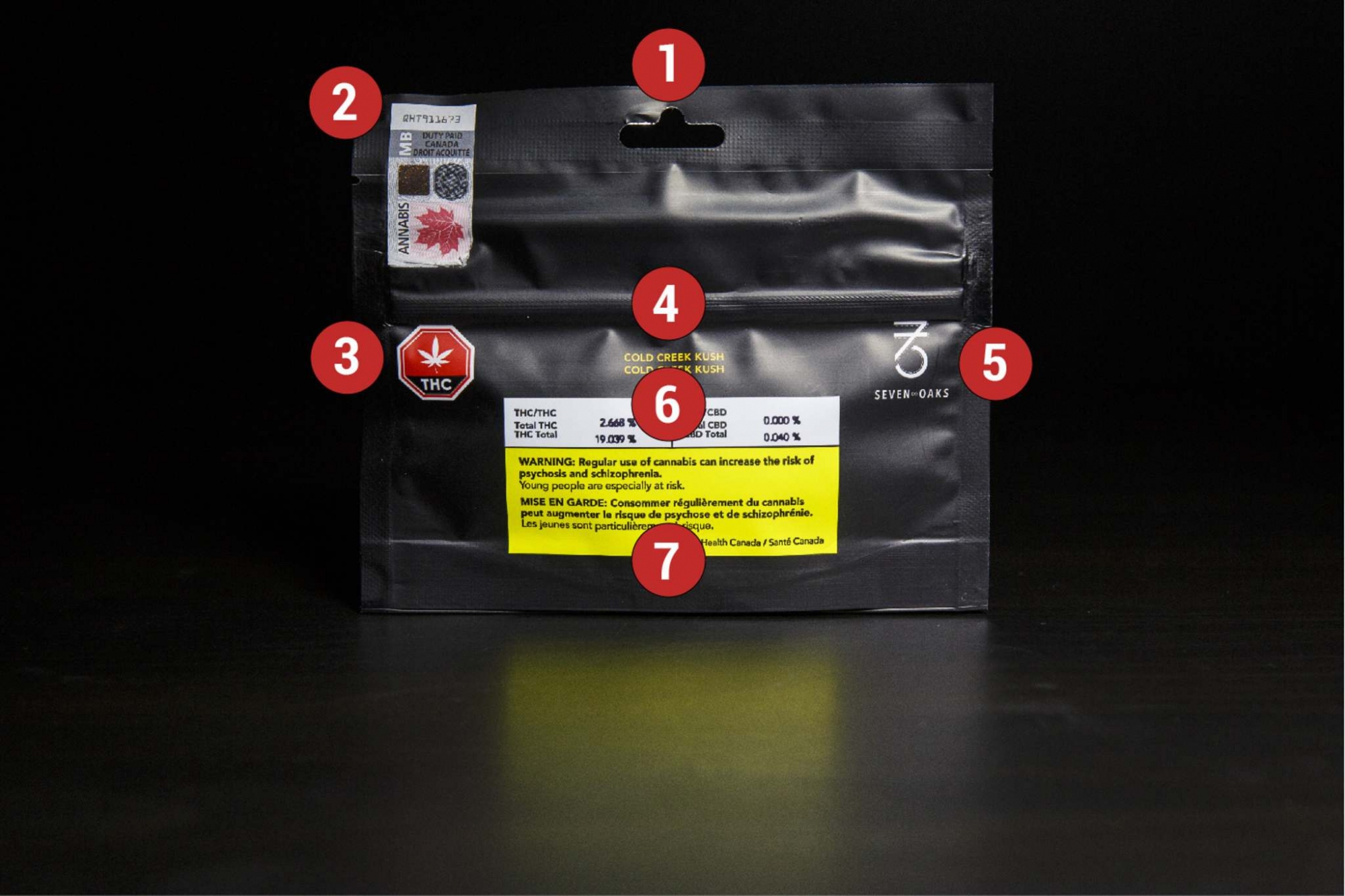How to read the label on your legal cannabis

Why is THC content shown twice? What's up with that stop sign logo? Your questions, answered.
So, you went down to the store and bought some legal cannabis. Congratulations!
Now, it's time to decode the mystery of Canada's legal cannabis packaging:
1. Colour
According to federal regulations, the exterior of cannabis packages must be one uniform colour. The inside can be a different colour.
2. Excise tax stamp
This stamp indicates that the manufacturer has paid the federal cannabis excise tax.
This special stamp indicates that the cannabis manufacturer has paid the federal cannabis excise tax to the Canada Revenue Agency.
That tax revenue gets split between the federal and provincial governments, with the provinces getting 75 per cent.
Each stamp has a unique identifying number, and is colour-coded to the jurisdiction where the cannabis is to be sold.
3. Standardized Cannabis Symbol
Health Canada's warning symbol must appear on any cannabis product that contains more than a negligible amount of THC.
That's short for delta-9 tetrahydrocannabinol — it's the primary chemical compound in cannabis that gets you high.
The symbol must be at least 1.27 square centimetres in size.
4. Strain name
The type of dried cannabis contained within the package.
The type of dried cannabis contained within the package. (This one's called Cold Creek Kush.)
Strain names aren't regulated and don't mean anything in and of themselves, but they've long been applied to different varietals of cannabis to help distinguish between them.
5. Brand name and logo
Licensed cannabis producers in Canada have taken to branding their product lines with names and logos.
Since Health Canada's promotional restrictions on cannabis are so tight, this is one of the few opportunities for weed companies to communicate brand information to their customers.
6. THC and CBD content
THC and CBD are two key cannabinoids, chemical compounds found in the cannabis plant that act upon human physiology. (There are actually well over 100 cannabinoids in cannabis, but THC and CBD are the best-understood at this point.)
Government-regulated cannabis packaging must display THC and CBD content as two separate figures.
Government-regulated cannabis packaging must display THC and CBD content as two separate figures. The initial, smaller number represents the actual amount of THC or CBD contained in the dried cannabis. The second, larger per cent figure represents how much THC or CBD the cannabis yields after the cannabinoids are activated by heat (for example, by smoking, vaporizing or cooking it). In other words, it's the larger figure that really matters to consumers.
In terms of potency, anything from 0 to 10 per cent THC might be considered relatively weak, while anything from 10 to 20 per cent THC would be moderately strong stuff by today's standards. THC content approaching 30 per cent would be quite potent for dried cannabis bud.
7. Warning label
All legal cannabis packages must feature black-on-yellow warnings from Health Canada.
All legal cannabis packages must feature these black-on-yellow warning labels with specific warning messages from Health Canada — each one contains a primary warning sentence followed by a secondary sentence.
The full list of warning messages is available here.
8. Strain description and terpene description
A description of the strain and terpene content is optional information.
This optional information includes the producer's description of the strain of cannabis inside the package, plus the primary terpene content of the cannabis.
Terpenes are smelly, oily compounds produced by many plants, including cannabis.
9. Net weight
How much cannabis is in the package, measured in grams.
10. Packaging date and expiry date
An expiry date is only required if there is data about the product's stability.
Cannabis producers can only include an expiry date for their products if they have specific data about the stability period of their product.
Otherwise, it's acceptable to print the phrase, "No expiry date has been determined."
11. Recommended storage conditions
Where should you keep your cannabis? (Our advice columnist Herb recommends an airtight container in a cool, dark place for dried bud, but producers might have other recommendations.)
12. Producer information
The name of the company that produced the cannabis.
By regulation, packages must include a phone number and email address for the producer.
13. Child safety warning
All cannabis packages must contain the statement: "KEEP OUT OF REACH OF CHILDREN / TENIR HORS DE LA PORTEE DES ENFANTS".
14. Lot number
Lot number could be useful if there's a recall.
This information could be useful in the event that a cannabis producer recalls its product.
15. Opening instructions
Since cannabis containers must meet a government childproofing standard, producers are allowed to include a black-and-white image with opening instructions.
420 Intel is Your Source for Marijuana News
420 Intel Canada is your leading news source for the Canadian cannabis industry. Get the latest updates on Canadian cannabis stocks and developments on how Canada continues to be a major player in the worldwide recreational and medical cannabis industry.
420 Intel Canada is the Canadian Industry news outlet that will keep you updated on how these Canadian developments in recreational and medical marijuana will impact the country and the world. Our commitment is to bring you the most important cannabis news stories from across Canada every day of the week.
Marijuana industry news is a constant endeavor with new developments each day. For marijuana news across the True North, 420 Intel Canada promises to bring you quality, Canadian, cannabis industry news.
You can get 420 Intel news delivered directly to your inbox by signing up for our daily marijuana news, ensuring you’re always kept up to date on the ever-changing cannabis industry. To stay even better informed about marijuana legalization news follow us on Twitter, Facebook and LinkedIn.














